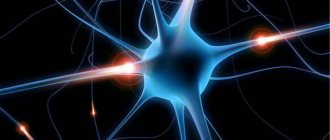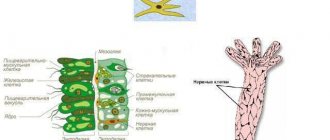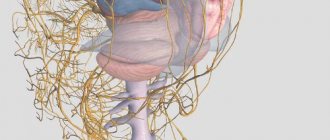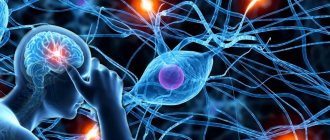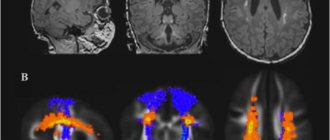TYPES OF NERVOUS SYSTEM
TYPES OF THE NERVOUS SYSTEM (types of higher nervous activity), complex basic. congenital and acquired individual properties of the nervous system of animals and humans, determining differences in behavior and attitude to the same environmental influences. The concept of T.n. With. introduced by I. P. Pavlov (1927). He identified three main ones. properties of nervous processes (excitation and inhibition): strength, balance of the processes of excitation and inhibition and their mobility (speed of transition from one state to another). There are 4 main types. The strong unbalanced type is characterized by the rapid development of positive (excitatory) conditioned reflexes (CR), while inhibitory RC are formed with great difficulty; In animals of this type, vegetative functions after their disruption are restored for a long time and unevenly. A strong, balanced inert type is characterized by the slow formation of positive and inhibitory UR, which means that after consolidation into a certain stereotype, the UR is retained. sustainability; reactions of adaptation and restoration of vegetative processes proceed slowly. In a strong, balanced, mobile type, positive and inhibitory URs are quickly formed and easily transformed when the stimulus changes; Animals of this type are characterized by easy adaptability of vegetative functions to changes in the environment, their rapid and complete restoration after eliminating the factors that caused the disturbance. The weak type is characterized by weak excitatory and inhibitory processes, URs are produced with great difficulty, and those formed are easily inhibited; vegetative processes are sluggish, easily disrupted, difficult and incompletely restored. People, as a rule, have various combinations of properties of various so-called. With. Neuroses and psychosomatic diseases more often occur in representatives with a predominance of a strongly unbalanced or weak type of nervous system.
In humans, in addition to common T. n. s., I.P. Pavlov highlighted special. types characterizing the interaction of the first and second signaling systems and the relationship between them: the mental type, with a predominance of the second signaling system over the first (a special development of the ability for abstract, abstract thinking is observed); artistic type, with a predominance of the first signaling system (a pronounced tendency towards figurative and emotional thinking; among people of this type there are many artists, writers, musicians, actors); medium type, when both signaling systems are represented in equal proportions. Most people are of the average type. They are characterized by a harmonious combination of figurative-emotional and verbal-logical. thinking. With the introduction of new research methods, the structure of technical sciences is being clarified. With.; new properties of the nervous system are described, e.g. lability and dynamism, characterizing the speed of nervous processes. Significant differences have been established. properties of the nervous system in different sensory organs (the phenomenon of partiality).
Types of higher nervous activity
The concept of the type of higher nervous activity. Conditioned reflex activity depends on the individual properties of the nervous system. The individual properties of the nervous system are determined by the hereditary characteristics of the individual and his life experience. The combination of these properties is called the type of higher nervous activity.
Properties of nervous processes. I.P. Pavlov, based on many years of studying the characteristics of the formation and course of conditioned reflexes in animals, identified 4 main types of higher nervous activity. He based the division into types on three main indicators:
1) the strength of the processes of excitation and inhibition; 2) balance, i.e. the ratio of the strength of the processes of excitation and inhibition; 3) the mobility of the processes of excitation and inhibition, that is, the speed with which excitation can be replaced by inhibition, and vice versa.
Classification of types of higher nervous activity. Based on the manifestation of these three properties, I. P. Pavlov identified:
1) the type is strong, but unbalanced, with a predominance of excitation over inhibition (“uncontrollable” type); 2) the type is strong, balanced, with great mobility of nervous processes (“living”, mobile type); 3) a strong, balanced type, with low mobility of nervous processes (“calm”, sedentary, inert type); 4) weak type with rapid depletion of nerve cells, leading to loss of performance.
I. P. Pavlov believed that the main types of higher nervous activity found in animals coincide with the four temperaments established in people by the Greek physician Hippocrates, who lived in the 4th century BC. e. The weak type corresponds to a melancholic temperament; strong unbalanced type - choleric temperament; strong, balanced, active type - sanguine temperament; strong, balanced, with low mobility of nervous processes - phlegmatic temperament. However, it should be borne in mind that the hemispheres of the human brain, as a social being, have more advanced synthetic activity than those of animals. A person is characterized by a qualitatively special nervous activity associated with the presence of his speech function.
Depending on the interaction and balance of signal systems, I. P. Pavlov, along with four types common to humans and animals, identified specially human types of higher nervous activity:
1. Artistic type. Characterized by the predominance of the first signaling system over the second. This type includes people who directly perceive reality, widely use sensory images, and are characterized by figurative, objective thinking.
2. Thinking type. These are people with a predominance of the second signaling system, “thinkers”, with a pronounced ability for abstract thinking.
3. Most people are of the average type with balanced activity of two signaling systems. They are characterized by both figurative impressions and speculative conclusions.
Plasticity of types of higher nervous activity. The innate properties of the nervous system are not immutable. They can change to one degree or another under the influence of upbringing due to the plasticity of the nervous system. The type of higher nervous activity consists of the interaction of the inherited properties of the nervous system and the influences that an individual experiences during life.
IP Pavlov called the plasticity of the nervous system the most important pedagogical factor. The strength and mobility of nervous processes can be trained, and children of the unbalanced type, under the influence of upbringing, can acquire traits that bring them closer to representatives of the balanced type. Prolonged overexertion of the inhibitory process in children of a weak type can lead to a “breakdown” of higher nervous activity and the emergence of neuroses. Such children have difficulty getting used to the new work schedule and need special attention.
Age-related characteristics of conditioned reflexes. Types of higher nervous activity of a child. Adaptive reactions of a newborn child to external influences are ensured by orienting reflexes. Conditioned reflexes during the neonatal period are very limited in nature and are developed only to vital stimuli. Already in the first days of a child’s life, one can note the formation of a natural conditioned reflex during feeding, which is expressed in the awakening of children and increased motor activity. Sucking movements of the lips appear before the nipple is inserted into the mouth. It is clear that such a reflex manifests itself only with a strict feeding regime for children. With a strict feeding regimen on days 6–7, infants experience a conditioned reflex increase in the number of leukocytes already 30 minutes before feeding, and their gas exchange increases before meals. By the end of the second week, a conditioned reflex appears in the form of sucking movements when the baby is positioned for feeding. Here the signal is a complex of stimuli acting from receptors of the skin, motor and vestibular apparatus, constantly combined with food reinforcement.
From the middle of the first month of life, conditioned reflexes arise to various primary signal stimuli: light, sound, olfactory stimulation.
The rate of formation of conditioned reflexes in the first month of life is very low and increases rapidly with age. Thus, a protective reflex to light occurs only after 200 combinations, if its development began on the 15th day after birth, and less than 40 combinations are required if the development of the same reflex began in a one and a half month old child. From the first days of a child’s life, unconditional (external) inhibition appears. The baby stops sucking if a sharp sound is suddenly heard. Conditioned (internal) inhibition is developed later. Its appearance and strengthening are determined by the maturation of the nervous elements of the cerebral cortex. The first manifestations of differentiation of motor conditioned reflexes are noted by the 20th day of life, when the child begins to differentiate the feeding position from the changing procedure. A clear differentiation of visual and auditory conditioned stimuli is observed at 3-4 months. Other types of internal inhibition are formed later than differentiation. Thus, the development of delayed inhibition becomes possible from the age of 5 months (M. M. Koltsova).
The development of internal inhibition in a child is an important factor in education. In the first year of life, it is advisable to cultivate inhibition, attracting facial expressions and gestures that characterize the negative attitude of adults, or stimuli that distract the child’s attention, i.e., they are an external inhibitor. For the proper development of a child in the first year of life, a strict regime is very important - a certain sequence of alternating sleep, wakefulness, feeding, and walks. This is determined by the significance of the stereotype of interoceptive conditioned reflexes at this age. By the end of the first year, complexes of external exteroceptive stimuli that characterize the situation as a whole become important. The word becomes one of the important components of the complex of stimuli.
The first signs of the development of the second signaling system appear in the child in the second half of the first year of life. During the development of a child, the sensory mechanisms of speech, which determine the possibility of perceiving a word, are formed earlier than the motor ones, with which the ability to speak is associated. The period of formation of the function is especially sensitive to formative influences, so you need to talk with the child from the first days of his life. When caring for a child, you need to name all your actions, name the surrounding objects. This is very important, since in order to form connections of the second signal system, it is necessary to combine the verbal designation of objects, phenomena, surrounding people with their specific image - to combine primary-signal irritations with secondary-signal stimuli.
By the end of the first year of life, the word becomes a significant irritant. However, during this period, children’s reaction to a word does not have an independent meaning; it is determined by a complex of stimuli, and only later does the word acquire the meaning of an independent signal (M. M. Koltsova). During the first year of life, the child actively trains in pronunciation, first of individual sounds, then of syllables and finally of words. The formation of speech function requires a certain maturity of the peripheral apparatus - the tongue, muscles of the larynx, lips, and their coordinated activity.
The mechanism of speech reproduction is associated with the complex coordinated work of the nerve centers of the cortex, the formation of certain connections between speech centers and motor areas. A close connection between speech function and motor activity has been shown, especially with finely coordinated movements of the fingers. By developing finely coordinated actions, you can accelerate the formation of speech skills.
A child’s speech develops especially intensively between the ages of 1 and 3 years. At this age, the child’s behavior is characterized by pronounced exploratory activity. The child reaches out to each object, feels it, looks inside, tries to pick it up, and puts it in his mouth. At this age, injuries easily occur due to curiosity and lack of experience, and the frequency of acute infections increases due to the child’s increased contact with other children and his environment.
The conditioned reflex activity of children of this age changes significantly. In the second year of life, individual objects begin to be isolated from the generalized undifferentiated world surrounding the child as separate complexes of irritations. This is made possible by manipulating objects. Therefore, you should not limit the movements of children: let them dress, wash, and eat themselves.
Thanks to actions with objects, children begin to develop a generalization function. Extensive use of objects develops a child’s motor analyzer. In the second year of life, a child develops a large number of conditioned reflexes to the relationship between the size, severity, and distance of objects (identification of faster and slower stimuli, larger or smaller in comparison with others). Of particular importance is the development of systems of conditioned connections to stereotypes of exteroceptive stimulation. In early childhood, dynamic stereotypes are especially important. With insufficient strength and mobility of nervous processes, stereotypes facilitate children’s adaptation to the environment; they are the basis for the formation of habits and skills. Noteworthy is the great strength of the system of conditioned connections developed in children under 3 years of age, and the associated pain due to the violation of the stereotype: children are capricious, cry if you stay with them for a long time; They do not fall asleep for a long time if they are placed in a new place. For children under the age of 3, the development of a large number of different stereotypes not only does not present difficulties, but each subsequent stereotype is developed more and more easily. However, changing the order of stimuli in one stereotype is an extremely difficult task. Systems of conditioned connections developed at this time retain their significance throughout a person’s subsequent life, therefore the formation of stereotypes that are beneficial for health and have educational significance is especially important at this age.
In the second year, increased development of speech begins, the child’s assimilation of the grammatical structure of the language, with a large role played by the imitative reflex. An adult, when communicating with a child, must pay special attention to the correctness of his speech.
At this stage of development, mastery of actions with objects also has a decisive influence on the formation of the generalization of objects into words, i.e., the formation of the second signaling system. As the child develops, the use of previously formed connections becomes increasingly important in developing new reactions. Systems of conditioned connections developed in early and preschool age (up to 5 years) are especially strong and retain their significance throughout life. This fact is important for teaching practice. The habits and skills developed at this age, which arose on the basis of strong conditioned reflex connections, largely determine a person’s behavior.
In preschool age, the role of the imitative and play reflex is very important. Children copy adults, their gestures, words, manners.
By the end of the preschool period, significant changes occur in the interaction of excitatory and inhibitory processes. As the cerebral cortex develops, the generalization of the excitatory process is gradually removed. Internal, conditioned inhibition is formed and becomes increasingly important. Differentiations are better developed, and periods of inhibition retention become longer. All this contributes to a more selective and adequate response of the child to external influences. At this age, the generalizing function of the word increases, the ability to generalize with words not only specific objects, but also many objects of the external world, categories of objects. So, the child begins to understand that a doll, a bear, a car are all toys, and toys, furniture, dishes, clothes are things. In older preschool age, the reflection of reality is already based on the development of complex systems of connections, including the interaction of the first and second signaling systems.
By the age of 6-7 years, reactivity to verbal stimuli improves. The nature of the interaction between the first and second signaling systems changes. In 3-4 year old children, the first signaling system prevails and has an inhibitory effect on the second. At 6-7 years of age, the increasing activity of the second signaling system has an overwhelming effect on the first signaling system. The development of the second signaling system is one of the important indicators of a child’s readiness for school.
At primary school age, as the cerebral cortex progressively matures, the strength, balance and mobility of nervous processes improve. The development of cortical inhibition processes creates conditions for the rapid and differentiated formation of conditioned connections. The formation of connections in the higher parts of the central nervous system is facilitated by the intensive maturation at this age of intracortical associative pathways that unite various nerve centers. In the process of learning to write and read, the generalizing function of the word continues to develop intensively. The importance of the second signaling system is increasing.
Some changes in conditioned reflex activity are noted in adolescence. The onset of puberty is characterized by increased activity of the hypothalamus. This causes a change in the balance of cortical-subcortical interaction, resulting in an increase in generalized excitation and a weakening of internal inhibition. Compared to the previous age group, the formation of temporary connections becomes more difficult in adolescence. The rate of formation of conditioned reflexes to both primary and secondary signal stimuli decreases. The peculiarities of the higher nervous activity of adolescents require an attentive attitude towards them and a thoughtful organization of the educational process.
Typological features of the child’s higher nervous activity. The formation of individual typological characteristics in the process of ontogenesis is determined by the gradual maturation of higher nerve centers. As will be shown below, during the development of a child, a change occurs in the relationship between the cerebral cortex and subcortical structures. This determines the characteristics of excitatory and inhibitory processes in childhood, and, consequently, the specificity of the manifestation of typological features. N.I. Krasnogorsky, studying the higher nervous activity of a child on the basis of strength, balance, mobility of nervous processes, relationships between the cortex and subcortical formations, and the relationship between signaling systems, identified 4 types of nervous activity in childhood.
1. Strong, balanced, optimally excitable, fast type. Characterized by the rapid formation of conditioned reflexes, the strength of these reflexes is significant. Children of this type are capable of developing subtle differentiations. Their unconditioned reflex activity is regulated by a functionally strong cortex. Children of this type have well-developed speech with a rich vocabulary.
2. Strong, balanced, slow type. In children of this type, conditioned connections are formed more slowly, and extinct reflexes are also restored slowly. Children of this type are characterized by pronounced control of the cortex over unconditioned reflexes and emotions. They quickly learn to speak, but their speech is somewhat slow. They are active and persistent when performing complex tasks.
3. Strong, unbalanced, highly excitable, unrestrained type. It is characterized by insufficiency of the inhibitory process, strongly expressed subcortical activity, not always controlled by the cortex. Conditioned reflexes in such children quickly fade, and the resulting differentiations are unstable. Children of this type are characterized by high emotional excitability, temper, and affect. Speech in children of this type is rapid with occasional shouting.
4. Weak type with reduced excitability. Conditioned reflexes are formed slowly, unstable, speech is often slow. Easy to brake type. Characteristic is the weakness of internal inhibition with strongly pronounced external inhibition, which explains the difficulty of children getting used to new learning conditions and their changes. Children of this type cannot tolerate strong and prolonged irritation and get tired easily.
Significant differences in the basic properties of nervous processes in children belonging to different types determine their different functional capabilities in the process of learning and upbringing. The effectiveness of pedagogical influences is largely determined by an individual approach to students, taking into account their typological characteristics. At the same time, we have already pointed out that one of the distinguishing features of the types of higher nervous activity in humans is their plasticity. The plasticity of the cells of the cerebral cortex, their adaptability to changing environmental conditions is the morphofunctional basis for type transformation. Since the plasticity of nervous structures is especially great during the period of their intensive development, pedagogical influences that correct typological features are especially important to apply in childhood. I. P. Pavlov considered the plasticity of types to be the most important feature that allows one to educate, train and remake the character of people.
In adults
The variation in nervous activity under consideration is characterized by the inability to tolerate super-intense stimuli: it can either switch off immediately (inhibition dominates the process of excitation), or it is “carried away” without brakes, which is accompanied by unexpected consequences (inhibition does not have time to cope with excitation).
Signs of a weak nervous system in adults are represented by the following manifestations.
People with the described variation in nervous activity are characterized by rapid fatigue. They need extra breaks to rest. Against the background of interference and in the presence of distractions, they experience a sharp decline in productivity.
They are also characterized by an inability to distribute attention between several simultaneous actions. They have difficulty coping with stressors. In conditions of intense functioning, their effectiveness declines, anxiety and uncertainty appear.
A weak nervous system is characterized by significant resistance to monotonous work, therefore representatives of the described type of functioning of the nervous structure tend to achieve better results in their usual daily activities. They work effectively according to instructions. They have the ability to systematize and plan work, and scrupulously control the activities performed.
The variant of the nervous structure under consideration is characterized by the presence of the potential to show reactions to signals of insignificant strength and to recognize similar stimuli. As a rule, it is sensitivity that determines the ability to notice nuances of shades, subtleties of sounds, notes of smells, as well as features of statements and halftones of interpersonal relationships.
In addition to the above, owners of a weak nervous system are characterized by stable indifference, which is expressed in the perception of any “blows” of fate without complaints, statements, or protests.
This type also affects the laziness of their owners. Moreover, it is found not only on the psychological level, but also has physical manifestations. Examples of this are subjects who exist outside of poverty, but at the same time, without making a single effort to change anything in order to improve their own existence and status in society.
A weak nervous system is also characterized by pronounced caution. In order to realize what they have planned or to carry out their plans, such individuals always wait for the right time, which often develops into a habit. This leads to the transformation of excessive caution and the desire to always play it safe into pessimism. Constantly thinking about the possibility of failure, which can lead to the collapse of life plans, gives rise to nervousness, indigestion, slow blood circulation and many other psychosomatic ailments.
